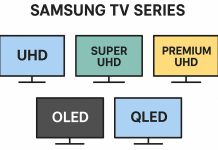The situation with Samsung’s OLED TVs is quite intriguing. If you go to Samsung’s US site and search for OLED TVs, the description will say “OLED TV (S95B OLED 4K Smart TV, 2022)”. However, on the same search on Samsung’s UK site, the description will say “QD OLED” (S95B QD OLED 4K Quantum HDR Smart TV). This raises an interesting question: does Samsung use different displays for its TVs in the US and UK? The answer is no. While the terminology is different, the TVs themselves use the same Samsung-manufactured displays.
The confusion has to do with Samsung’s marketing. Samsung’s OLED panels, manufactured at a plant in Asan, Chungcheongnam-do, South Korea, began production in late 2021. Initially, Samsung decided to shift its focus from large LCD panels to OLED technology. However, by 2024, mentions of QD-OLED had disappeared from their website, and the reason for this is quite simple: Samsung was unable to meet the demand for their own panels and as a consequence, started sourcing OLED panels from LG.
As for the Australian market, while it may seem that only OLED TVs are available there, in fact Samsung’s offerings are still based on QD-OLED panels from Samsung as much as OLED from LG as in other regions.
OLED panels from LG and Samsung, technology
LG and Samsung’s OLED panels are built on the same principle: a substrate on which organic LEDs, each emitting a single color, are applied. Above these LEDs is a layer of filters that allow a single band of color emitted by a sub-pixel to pass through. LG adds a patented fourth white subpixel, which is designed to reduce power consumption and increase the life of the display.
Technical differences between the OLED displays of Samsung and LG TVs
The first difference is the sub-pixel arrangement: LG’s OLED panels use 4 sub-pixels (red, blue, green, white). This is done to increase the lifetime of the OLED panel. LG never turns on all the subpixels at the same time. If you want to create white color, only white pixels will be included. LG has OLED EVO screens, a new generation of displays. To increase the light output, there are mirrors near each subpixel that redirect the light output outside the display, preventing it from being lost inside. This is an undoubted advantage, because at the same power consumption the light flux is 30% higher. It’s also worth noting that the pixels are arranged in a single line. Samsung uses only three subpixels (red, blue, green), and they are arranged in the shape of a triangle. Because of this layout, power consumption is slightly higher and more heat is generated, but the advantage is higher brightness.
The second difference, according to Samsung, is the use of blue OLEDs as backlighting, which is considered better than white LEDs. However, it is more likely that Samsung’s OLEDs are white and use an additional blue filter. Blue OLEDs have the shortest lifespan. Samsung has even applied for the trademark QD-OLED POWERED BY QUANTUM BLUE.
The third difference is the use of a color filter in Samsung’s OLED displays made with quantum dots (QDs). But it should be noted that such materials are used by all display manufacturers and are designed for use in light filters with high light transmission in a certain range. For example, if you look at a light source through a brown or green bottle, you will see that about half of the light is lost as it passes through it. In contrast, the materials used in displays allow 95-98% of light to pass through in the respective red, blue, and green color ranges. This results in increased brightness and improved contrast.
LG OLED and Samsung OLED aging
You should know that OLED TVs tend to age over time. The lifespan of the first OLED TVs was around 15,000 hours, which is about 1.5 years of constant use. However, after reviewing Samsung’s OLED manual, I found no mention of TV lifespan. The 15,000 hour estimate is based on feedback from TV owners and the practice of using sample TVs in stores. In the home, first-generation OLED TVs are likely to last about 4-7 years, depending on the intensity of use. However, according to feedback from store employees, the show samples in stores show signs of screen burn-in after about a year of use.
As for the new OLED panels after 2022, the burn-in problem has already been largely solved by LG. The use of new materials and the ability to care for the panel (care programs that correct burn-in) have greatly minimized the risk of residual image retention, thereby extending the life of OLED TVs. As far as Samsung is concerned, not much time has passed since the introduction of QD-OLED TVs (2022) and it is too early to talk about any statistics.
Why OLED Displays Age (Burn Out)
OLED displays emit light when voltage is applied. As voltage flows through the OLED, physical processes occur that cause the OLED to emit light in the visible spectrum. However, during this process, chemical reactions also take place within the LED, gradually deteriorating its material. Over time, this leads to a decrease in the intensity of the emitted light. The higher the applied voltage, the faster the degradation of the OLED material, causing it to lose its properties. Additionally, the degradation process intensifies at higher temperatures.







